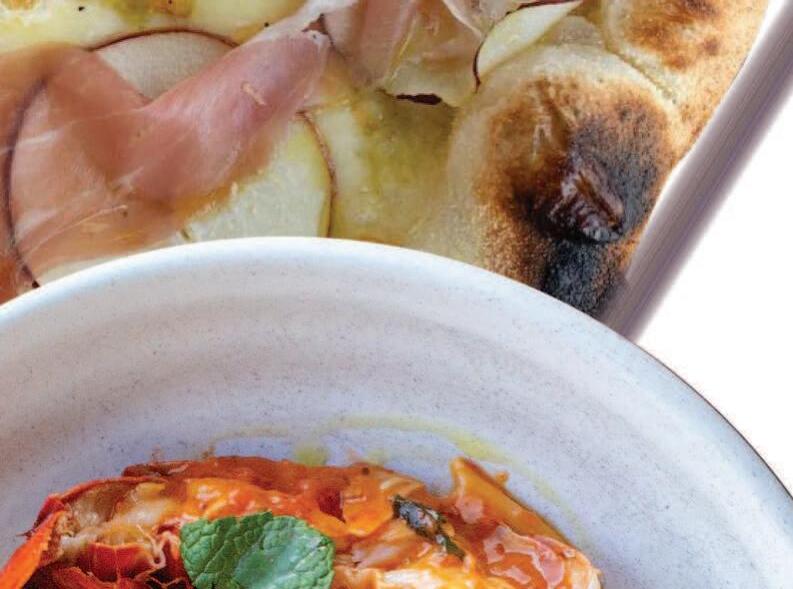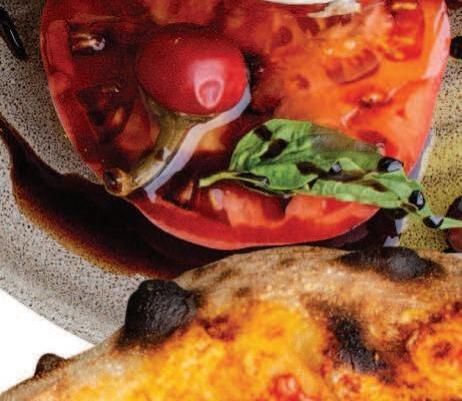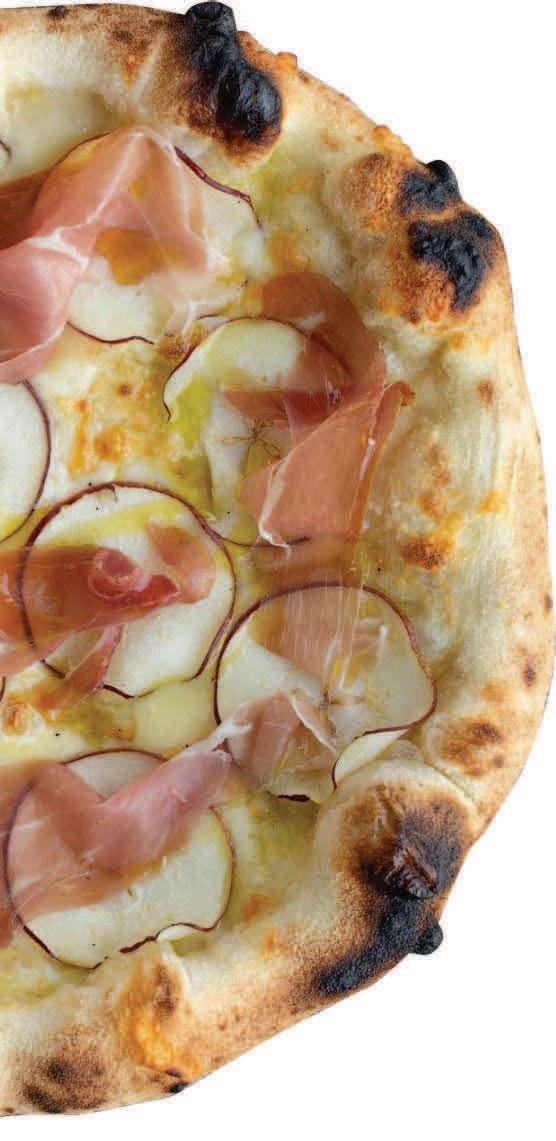HOW DO STL RESTAURANTS SOURCE Sustainable Seafood?


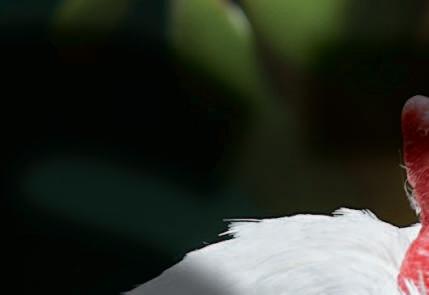
Second Chances at



Second-Hen’d







HOW DO STL RESTAURANTS SOURCE Sustainable Seafood?



Second Chances at










We knowwhere toget a bite—whetherit’s fresh,farm-to-tablefoodsservedatlocallyowned restaurantsor a closeencounterwith a sharkat WondersofWildlifeNationalMuseum & Aquarium. We loveourcityandknowthe bestplacestoeat,drinkandplay.
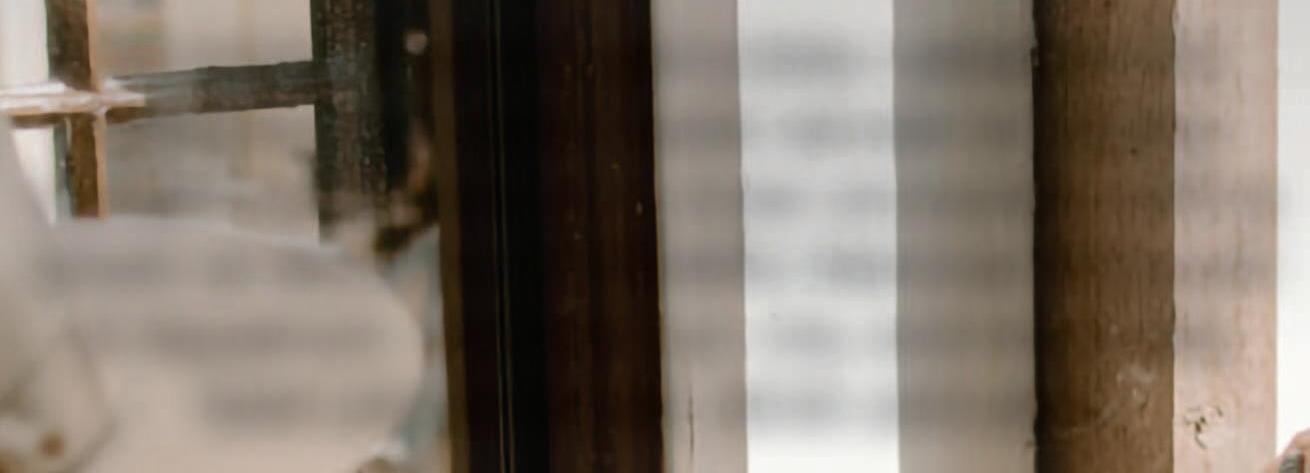

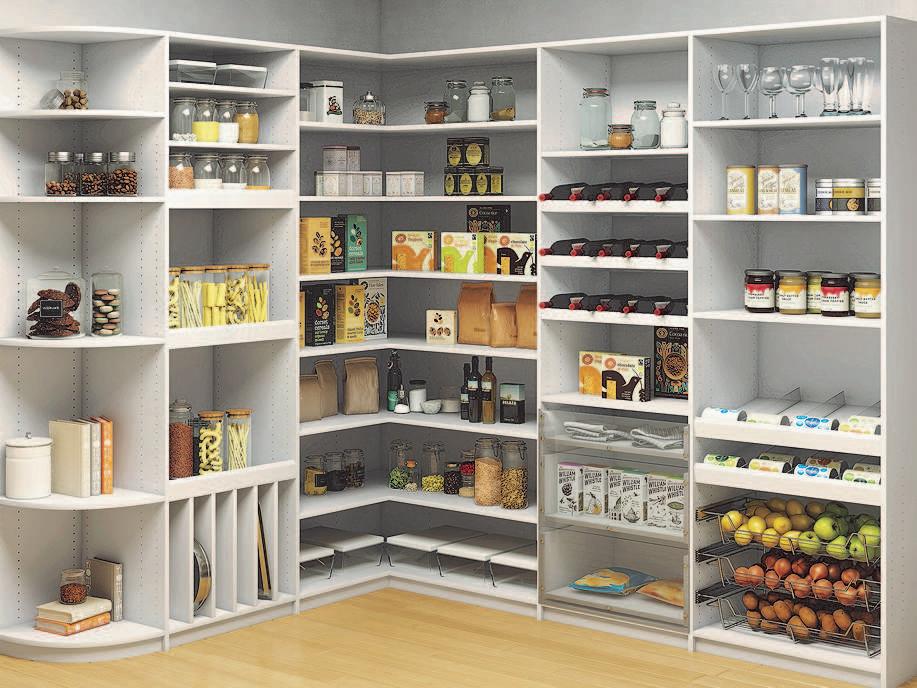









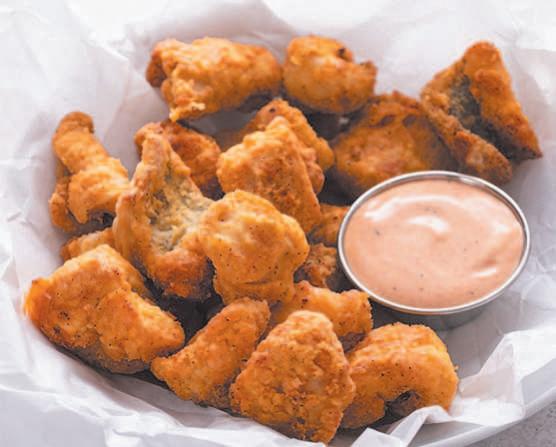

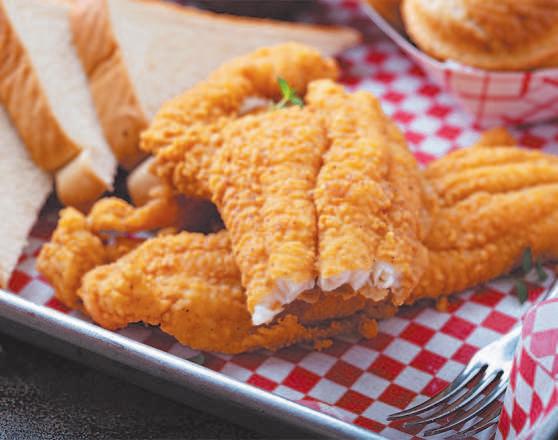












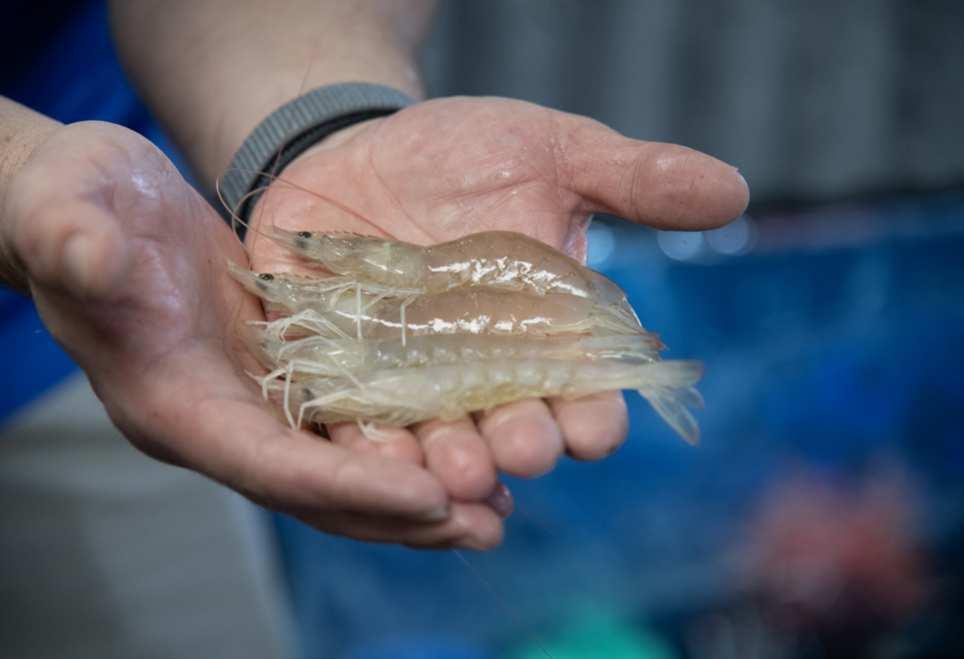



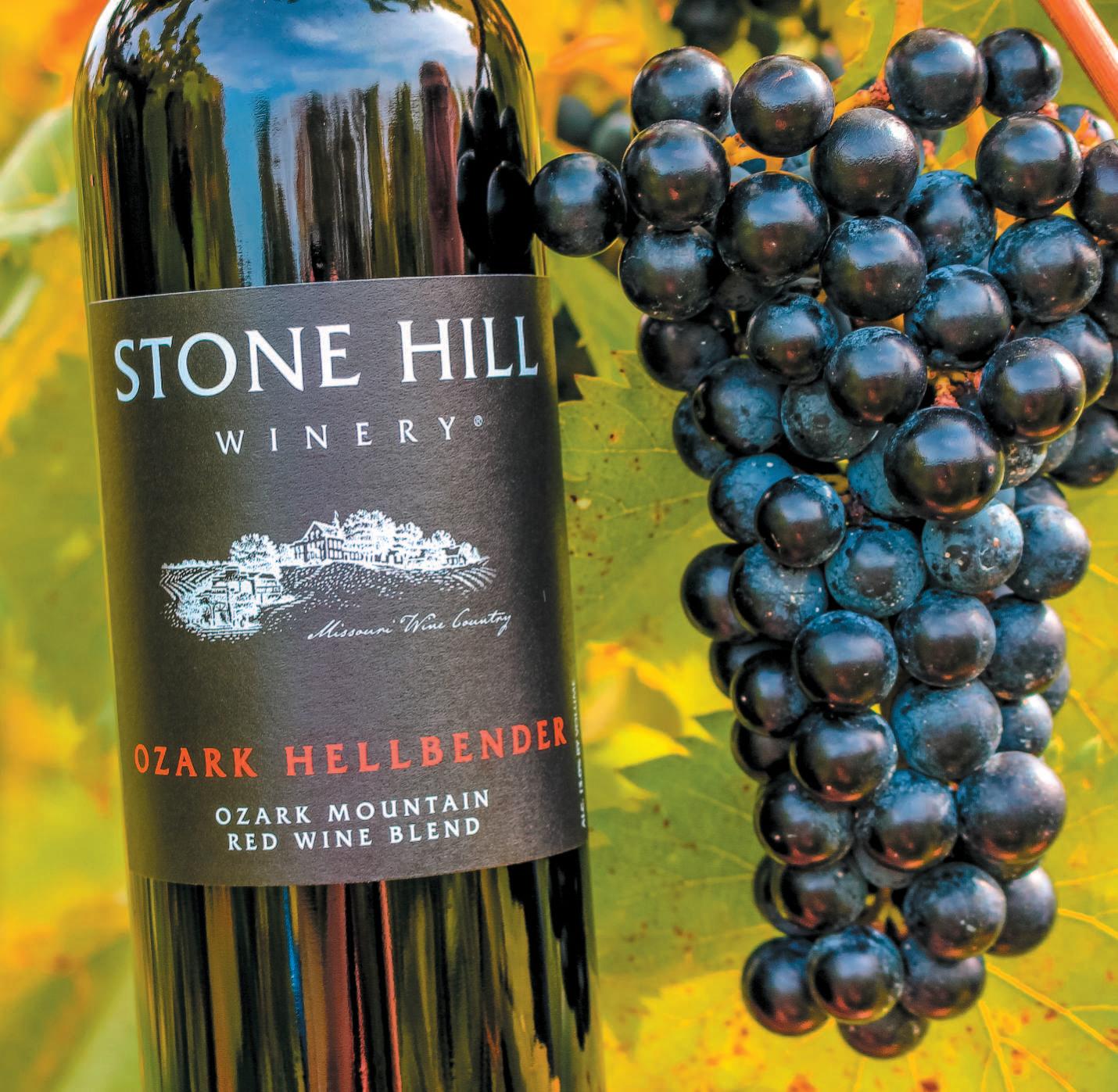


















Inspired Local Food Culture / st . louis

PRESENTEDBY
Nursesinourcommu ities have dedicatedtheirlives tohelpingothers.The y,


EDITORIAL
EDITOR IN CHIEF
Emily Adams, emily.adams@feastmagazine.com
MANAGING EDITOR
Mary Andino, mandino@feastmagazine.com
DIGITAL EDITOR
Shannon Weber, sweber@feastmagazine.com
ASSOCIATE EDITOR



Charlotte Renner, crenner@feastmagazine.com
ASSISTANT EDITOR
Emily Standlee, estandlee@feastmagazine.com
PROOFREADER
Alecia Humphreys
CONTRIBUTING WRITERS


Kate Pogue, Gaby Weir Vera, Jiana West
CONTACT US
Feast Magazine, 901 N. 10th St., St. Louis, MO 63101 | 314.475.1260 | feastmagazine.com
MARCH 2023
VOLUME 13 / ISSUE 3
SALES
VICE PRESIDENT OF SALES
Kevin Hart, khart@stlpostmedia.com
MEDIA STRATEGIST
Erin Wood, ewood@feastmagazine.com
ART
ART DIRECTOR
Dawn Deane, dawn.deane@feastmagazine.com
ASSISTANT ART DIRECTOR
Laura DeVlieger, ldevlieger@laduenews.com
CONTRIBUTING PHOTOGRAPHERS
Christina Kling-Garrett, Sean Locke, Ben Nickelson, Jennifer Silverberg
To distribute Feast Magazine at your place of business, please contact Rich Hudson at rhudson@post-dispatch.com.

SPONSOREDBY
Showyourgratitude: STLtoday.com/contests
4/13
The Great Taste
Thursday, April 13, begins at 7 p.m. $45 for general admission, $65 for VIP Saint Louis Science Center, 5050 Oakland Ave., St. Louis, Missouri
Explore the Saint Louis Science Center after hours while tasting from restaurants around St. Louis. The annual Great Taste event will feature tastings from area restaurants included in the 2023 edition of Ian Froeb’s STL 100. Guests will spend an evening enjoying live music, items from local vendors, complimentary tastings from restaurants and more. Tickets are on sale now at STLtoday.com/ourevents.

“it’sjusttheirjob”–w now it’smuch more.
Letusknowwhothe rean howthey’vechanged our life.

The topic of sustainability has become irreversibly tethered to the topic of food culture in recent years – and rightly so. It seems that each conversation throughout the industry has a resounding underlying tone of, “How can we do better?”
While creating this edition of Feast, we asked that question again and again – of our local farmers, makers, restaurateurs, and of ourselves. We filled these pages with just a handful of those answers.
From sustainably grown produce and educational programs (p. 20) to chefs developing menus with intention (p. 10) to favorite mainstay eateries doing vegan the sustainable way (p. 16), we found that the metro area abounds with people putting the environment at the forefront.
On p. 24, managing editor Mary Andino talks with Erica Camp – army veteran and founder of SecondHen’d – about the work the nonprofit is doing to rehome “spent” hens in the metro area. Camp shared the shocking statistic that egg producers dispose of about 300 million of these animals each year in the U.S. alone – and inspired our staff with her commitment to give
hens a second chance at a happy life in the Midwest.
Speaking of the Midwest, have you ever wondered how our land-locked region sources its seafood? On p. 22, assistant editor Emily Standlee does a deep dive into how St. Louis farms and restaurants are making efforts to source seafood more sustainably –and how you can cater your orders to be more eco-conscious as well.


To build a greener kitchen in your own home, turn to p. 31, where digital editor Shannon Weber shares her favorite tips, tricks and locally sourced essentials.
Looking for more ways to help? Turn to p. 21, where associate editor Charlotte Renner gives the 411 on community gardens and how you can get involved in such an initiative in your own neighborhood.
Each eco-friendly effort covered in this edition is one small – albeit significant – step amid a much larger problem, of course …


But it’s a start.
Comejoinus
55thSt.Louis
AntiqueFestival


April22&23,2023
•Climatecontrolledenvironment.

•Spaciousandfullmenu concessions.
•Freeandcloseparking.
•70premiumworldclassdealersspaces ina30,000sfcomfortableshowroom.
•Findthecollectiblesyou’vebeen lookingfor.
Purchaseantiquesasinvestments
Formoreinformationcall: 608-346-3797

oremail: stlouisantiquefestival@gmail.com
Emily Adams emily.adams@feastmagazine.comMerchandiseondisplayandforsale:Dresden,Meissen,porcelain,jewelry,Nippon,knives, Orientalia,artglass,artpottery,bronzes,ArtDeco,ArtNouveau,paintings,furniture,silver,china, countrystore,quilts,clocks,FrenchCameoglass,lamps,photographs,CivilWar,coins,dolls,toys, signs,sports,advertising,paper,glassware,prints,statuary,majolica,oldwestmemorabilia,tools, musicalinstruments,linens,Tiffany,collectiblesandmore.
At Rock Star Tacos on The Hill, chef Wil Pelly is dishing up Mexican- and Cuban-inspired fare with a rock ‘n’ roll theme. This is fun, delicious food, and the menu’s rock puns can’t be beat. I mean, c’mon, Curd Eye Blind? That’s good stuff.


Where Rock Star Tacos, 4916 Shaw Ave., The Hill, St. Louis, Missouri • More info 314-571-9016; rockstartacos.com
Menu Tacos and other Mexican fare • Hours Dinner Tues. to Sat. (closed Sun. and Mon.)
Honey Bee’s Biscuits + Good Eats has opened a new brick-andmortar store in Kirkwood. Married duo Meredith and Michael Shadwick launched Honey Bee’s in 2020 at the Kirkwood Farmers Market, and the popularity of their biscuits has allowed them to grow since then. The biscuits really are that good – but the gravy might be the real revelation.
Where Honey Bee’s Biscuits + Good Eats, 200 N. Kirkwood Road, Kirkwood, Missouri • More info 314-650-0762; honeybeesbg.com
Menu Biscuits, biscuits and gravy and breakfast sandwiches
Hours 8 a.m. to 1 p.m. Thurs. to Sun. (closed Mon. to Wedn.)
Married couple Sophie Mendelson and Martha Bass have opened the brick-and-mortar location of their ice cream sandwich shop, Sugarwitch, in the Patch neighborhood of South City. If you just drove past (let alone visited) Sugarwitch when it was a pop-up outside Olio in 2021, you suspected Mendelson and Bass were onto something special, and the new storefront proves it.
Where Sugarwitch, 7726 Virginia Ave., Patch, St. Louis, Missouri
More info 573-234-0042; sugarwitchic.com • Menu Ice cream sandwiches, baked goods and other frozen desserts • Hours 3 to 9 p.m. Fri., 11 a.m. to 7 p.m. Sat. and Sun., 8 a.m. to 1 p.m. Mon.





SPRING IS PEAK MUSHROOM SEASON, SO EXPLORE THE FANTASTIC WORLD OF FUNGI BY VISITING YOUR LOCAL MUSHROOM GROWERS AND FORAGERS.
We’re all familiar with the fresh and dried mushrooms lining the shelves at our nearest conventional supermarket. But face it: They’re boring, a little sad and you deserve better. The St. Louis area has two notable mushroom growers – Mushrooms Naturally and Ozark Forest Mushrooms – that make the rounds at area farmers markets and sell directly to buyers. Both offer some of the most beautiful mushrooms around – lion’s mane, grey oyster and black poplar, to name a few. Some, like chanterelles and black trumpets, show up seasonally, while many others are available year-round.
Mushrooms are a joy to work with; each one has its own shape and flavor profile. Talk to producers about what they like to do with each variety, and they’ll have plenty of suggestions. A conserva is a great way to extend the lives of highly seasonal varieties like chanterelles, and it’s one of the simplest things you can do with them. Roast or sauté them to sit atop grains, greens or pasta. Use them in soups or stews, simmer them in sauces for poultry or beef or throw them into stir fries or curries; whatever you dream up, there’s a mushroom for it.
SERVES | 4 TO 6 |
Asurprisinglysatisfyingvegetarianweeknightmealcomesfromthecombinationofhearty polentaandmeatymushrooms,andyouwon’tneedanythingmorethanagreensaladalongsideit.
POLENTA
3 cupswholeor2percentmilk
3 cupswater
2 tsp koshersalt
SAUTÉED MUSHROOMS
3 Tbspoliveoil
3 Tbspunsaltedbutter
1½ Tbspfreshsageleaves, finelychopped
1½ Tbspfreshrosemaryleaves, finelychopped sprigsfreshthyme
¼ cupshallots,minced clovesgarlic,minced
1½ cupscoarsegrindpolenta
3 Tbspunsaltedbutter cupParmesancheese,freshlygrated
1½ lbsfreshmixedmushrooms (oyster,maitake,shiitake,beechoryour favorites), trimmedandsliced

¹⁄₃ cupdrywhitewine
Tbspsherryvinegar
pinchredpepperflakes
koshersaltandfreshgroundblack pepper,totaste
Ozark Forest Mushrooms is a regular at Tower Grove Farmers' Market, and Mushrooms Naturally attends the Lake St. Louis market. Check their websites for info on buying, hours and market attendance. ozarkforest.com; mushroomsnaturallystl.com.
/ preparation – polenta / Bring milk, water and salt to a boil in a large saucepan over medium-high heat; slowly stream in polenta, whisking constantly. Continue to whisk until mixture starts to bubble; reduce heat to low and cook, stirring frequently, until polenta is tender, 30 minutes. If polenta cooks too fast, add more water as needed, ¼ cup at a time. Remove from heat, and stir in butter and cheese; cover and set aside as you make the mushrooms.
/ preparation - mushrooms/ Heat oil and butter in a 12-inch cast iron skillet over medium heat. Stir in herbs and cook, 3 to 4 minutes. Add shallots and garlic and cook until tender, 2 minutes. Add mushrooms, and toss to coat; cook over medium heat, stirring occasionally, until mushrooms have released their juices and are tender, 8 to 10 minutes. Add wine, vinegar and red pepper flakes and bring to a light boil over medium-high heat, stirring constantly, until liquid has reduced. Season to taste. / to serve/ Divide polenta on plates, top with mushrooms, and serve warm alongside a green salad.

Ryan McDonald had spent half his life working alongside critically acclaimed chefs like Josh Galliano and Cary McDowell until 2018, when he became executive chef and co-owner of Good Fortune Restaurant in Botanical Heights. Now, with Farm Spirit, McDonald has found his own rhythm, cooking what he wants, changing things up and branching out in all directions. From pantry staples to dishes at farmers markets and festivals, McDonald s doing it with intention by building every aspect of the business on a foundation of sustainability.
Why is sustainability so important to you? Sustainability is at the core of everything we do with Farm Spirit. We and many other farmers and food producers work their butts off to grow and raise incredible product, and it is purely my responsibility as a chef, and quite frankly as a human, to make sure it goes to good use! Whether we’re talking about farming practices, techniques and recipe development in the kitchen, or just leaving your lights on at home when you’re gone, the bottom line is just do the right things, for the right reasons. No need to overcomplicate it; just do your part in the ways that you can.
What sustainable practices do you employ with Farm Spirit’s grab-and-go products and hot food pop-ups?

Our partnership with Such and Such Farm was built with sustainability in mind, through vertically integrating our practices. My food source is usually 300 feet from my production kitchen, and it doesn’t get much better than that. Farm Spirit utilizes extra market produce as well as what would be compost to create prepared items, which gives them a new purpose. We practice a lot of fermentation and preservation techniques that
allow us to use every last bit of produce in one way or another. We butcher whole animals and use every single bit of them in unique ways. The small amount of food waste we produce goes to compost and turns into garden soil in coming years. You’ll even find the barn adorned with leftover cleaned pig bones from the stockpot. We’re just trying to do our best and look forward to continuing and improving on that.
In what ways can people be more sustainable in their own home kitchens? There’s a few simple steps anyone can do to be more conscious in your home kitchen. Buy your food from great farmers and producers, and do so with intention! After you buy that food, eat it all, and don’t let it go to waste. There are lots of cool things to make with leftovers and scraps, and it’s a fun way to get creative in your kitchen. Lastly, I highly suggest growing a garden. Big or small, it doesn’t matter; just start with your favorite things to eat, and see how it goes. Worst case scenario, you spend some time outside in the sun and learn what you want to grow next year.
Farm Spirit,instagram.com/farmspiritstl
“I must admit – salumi is my love language. It’s so fun to make and crazy tasty! You can slice our coppa and lonza really thin and make rich, luxurious sandwiches. Use our pancetta or guanciale to make carbonara or pasta alla gricia. Make a nice charcuterie board for a dinner party with thin slices of an assortment of meats. My favorite is soppressata.”

“We started making this because it was one of my favorite sleeper condiments for a long time. It’s so versatile, and adds great spice and texture to a dish. Use it in rice and noodles, on top of your eggs, as a base for dressing or spicy mayonnaise or braise cabbage, and finish with chili crisp, sugar and fish sauce. It’s even great for adding a little kick to your brothy soup and so many other things.”
“After years in restaurants, it’s really freeing to be able to cook what I want and allow the menu to change frequently. I use whatever products I can get each week from the farm to create some fun and fresh dishes for market customers. We will keep a few staples with an ever-changing menu of ready-to-eat, prepared and value-added items. Definitely looking forward to feeding lots of folks at Tower Grove Farmers' Market this year!”


ingredients?
AK: We gather from our property and from family friends around here, so most of our stuff comes off of probably 100 acres. We try to harvest what won’t kill whatever we’re harvesting, so leaves and seeds we can harvest after the plant has died. Or for certain leaves, we can prune those branches in the spring. We use a lot of species that have been naturalized and are invasive in nature, so there will always be plenty.
MJ: Certain ingredients we know when to harvest and how to keep throughout the year. For instance, today we’re brewing with sassafras leaves. We realized that, at the end of the season, if we can collect branches before they die, we’ll have them to brew with for the rest of the year. So we’re using what we harvested in the fall in this beer now, when it’s barren in our woods.
What flavor profiles can foraged ingredients bring to the beer?

MJ: Each part of the hickory tree lends a different flavor and aroma. We toast the bark to get this kind of campfire, marshmallow sweetness. The leaves give more of an earthy spice, sometimes fruity character. And the nuts themselves lend a nutty character.
AK: Cherry bark has some stone fruit qualities. It gives the beer a dark reddish color and kind of an amaretto flavor.

What items do you most look forward to harvesting while foraging?
Celebrating its 10th year anniversary this April, farmhouse brewery Scratch Brewing Company has grown into its southern Illinois surroundings and blossomed into a thriving local business. Co-owners Aaron Kleidon and Marika Josephson have streamlined their foraging approach to get more mileage out of harvests and utilize as many parts of the plants as possible to craft their brews. “It’s always been part of our mission to not just showcase the flavors here, but to keep things as local as possible,” Josephson says. “This way of making beer – where we’re ordering less from far away, supporting local farmers, nurturing plants that grow natively – those all help to create a more sustainable lifestyle.”
MJ: Mushrooms. We were low last year because it was dry, and we just didn’t collect a lot of chanterelles. Most years, we get as much as 120 pounds, so we’ll definitely be dancing if our harvest is better this year. People will ask when our Chanterelle Biere de Garde is coming out, and the answer is, we’re not making one – or not the one we normally make – because we simply didn’t find enough mushrooms. It was too warm, and there wasn’t enough moisture during the right time of year. For us, it’s also a way of just telling the story about plants and the environment and what’s going on.
Scratch Brewing Co., 264 Thompson Road, Ava, Illinois, 618-426-1415, scratchbeer.com

The
This lightly tart farmhouse beer is dry-hopped with Illinois-grown Mackinac hops that complement the tropical lemongrass-ginger aroma.
WRITTEN BY KATE POGUE | PHOTOS COURTESY OF SCRATCH BREWING COMPANYPRESENTED BY
Linguinewith
Creamy Bell Pepper and Tomato Sauce
2 bellpeppers, diced
1 yellow onion, diced 2 scallions
1 Tbsp olive or avocadooil
1 lb sweet Italianchicken sausage
Salt and pepper, pinch
BROWNRICE


Ideal forpeople whohave allergiesor sensitivities towheat orgluten,brown-ricepasta is a hearty,versatileoption.Itstaste and texture are muchlikewholewheat pasta, so it canbe swapped in foranythingfromspaghetti to lasagna.Like other whole-grain versions, brown-ricepasta is loadedwithfiber,whichleads to greater satiety.
QUINOA
Althoughquinoa ismostoften usedas a substituteforrice,the seeds canalso begroundinto flour to makepasta.The result is a gluten-free,high-protein, high-fibernoodlewith a nutty taste.Products derivedfrom quinoa are digestedmore slowly, which canhelppreventblood sugarfromspikingandthen crashing.
SOBA

Soba noodlesmightnot be considered pasta inthe traditional sense,butthey area key ingredientinmanyJapanese dishes andthey’re fullof manganese, which canhelpwith a healthy immune system.Made frombuckwheat, soba noodles areacomplete protein,meaning theycontain every essential aminoacid.Theywork in cold noodle salads, hot soups and stir-friesalike. Soba noodlesare comparatively low in caloriesand a healthy choiceforpeopleon anti-inflammatory diets.
HankDart,aseniorhealthcommunications leadatSitemanCancer Center,knowsthat whenpeoplehear“wholegrains,”theydon’t typicallythinkofpasta—butmaybethey should.Shelvesinthepastaaislearenow stockedwithfarmoreoptionsthantraditional noodlesmadefromrefineddurumwheat(also knownassemolinaflour).“Themostcommon whole-grainpastaismadewith100%whole wheat,buttherearesomeothertypesaswell,” Dartsays,“suchasthosemadefrombrown riceand quinoa,whichisofficiallyaseed,but it’susually includedwithgrains.”


There’sasignificantdifferencebetweenhow whole-grain pasta andsemolinapasta are made.Traditionalpastaisrefined—thatis, thegermandbranareremovedwhenthegrain isprocessed—butthat’spreciselywheremany ofthenutrientsare.Whole-grainpastakeeps thegermandbranintact,aswellasallthevital nutrientsthatcomewiththem.“Thatcanhelp
giveanaddedboostto yourhealth,”Dartsays. “Wholegrainsareagreatsourceofvitamins, minerals,fiber andother nutrients.Adietrich inwholegrainshasbeenfoundtolowerthe riskofdiabetes,cancerandheartdisease— andmayevenhelpwithlongevity.”
It takesafewminuteslongertocookwholegrainpasta,anditcanhaveafirmertexture. Thenoodlesalsohaveanuttytaste,whichcan beanadjustment,butDarthasasolutionfor that: “Onewaytohelpeasetheswitchisto mixwhole-grain pasta in withrefined-grain pasta.Then,overtime,slowlyincreasethe amountofwhole-grainpasta youuse.”Serving whole-grainpastawithathick,heartysauce ratherthanathin,sweetoneisanotherwayto mitigateitsmorepronouncedflavor.
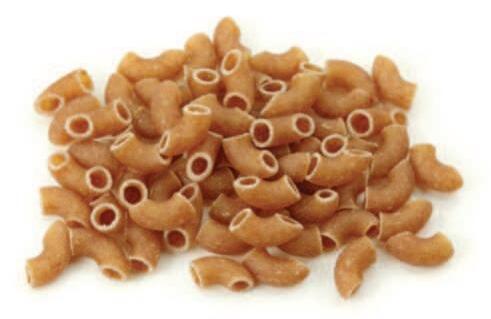
It mighttakesomeexperimenting,butthe healthbenefitsofincorporatingwhole-grain pastainto yourdietarewellworthit.“Agood

WHOLEWHEAT
Whole-wheat pastaretainsthe crucialnutrients— including B vitamins, vitaminE,protein andhealthyfats— thatare strippedfromthebranand germ whenthey’re processed to make traditional refined pasta.It’s also higherinfiberand a littlelower in calories Whole-wheat pasta canhelp keepbloodsugarsteady, and,as partof a dietrichin wholegrains, helpwithheartand digestive health.
8oz whole wheat pasta (or other wholegrain pastavariety)
2 Tbsp Italian seasoning
4oz tomatopaste
¼ cup water
4 oz milk
2oz creamcheese
2oz sourcream
2 Tbsp butter
¼ cup Parmesancheese

Bring a large potof water to boil. Wash, core, seedand dice bellpeppers andonion. Trimandthinly slicescallions, separating whitesfromgreens. In a mediumskillet,heat a drizzleofoil overmediumhighheat,addbellpepperand onionand cookuntil softened, about 4to5 minutes.Add sausage and scallion whites. Break sausage upinto pieces and cookthrough,about 6to8 minutes.Seasonwithpinchof saltandpepper.
overallgoalistomakewholegrainsatleast halfofthegrains youeateveryday.That translatestoaround3to4ouncesofwhole grainsdailyformostadults,”Dartsays.
“Addingwhole-grainpastasto yourmenucan beaneasyandtastywaytoworktowardthat.”
Oncewaterisboiling,add pasta and cook,stirringoccasionally untilaldente. Reserve½ cup pastawater. While pasta cooks, addItalian seasoning and tomatopaste intopanwith sausage mixture. Tosstocoat. Pourin ¼ cupplain waterand bring toa strongsimmer.Cook forabout 2 minutesandthen reduce heat to low.Addmilk, creamcheese and sourcream topanwith sauce.Stirinbutter untilmelted. Adddrained pasta topanwith sauce, tosstocoat. Ifneeded,addsplashesof pasta wateroneat a time to achieve desired sauceconsistency. Divide pasta into4 bowls, and topwith Parmesanand scallion greens(ifdesired).






 STORY AND RECIPE BY GABY WEIR VERA, PRIVATE CHEF / PHOTOS BY BEN NICKELSON
STORY AND RECIPE BY GABY WEIR VERA, PRIVATE CHEF / PHOTOS BY BEN NICKELSON


From just three whole beets, make crunchy, satisfying croque es, green chips and a refreshing balsamic-beet shrub. The croque es are delicious drenched with a blue cheese dip and a drizzle of local honey. The chips are crispy, fun and kid-friendly. The shrub is an interesting approach to making something special from what most would consider to be waste. Maximizing the potential ingredients have to offer, while minimizing waste, is a philosophy these recipes stand by: Waste not, want not.
YIELDS | 20 PIECES |

3 largebeets,withgreentops cupswater,plusmoreasneeded
½ cupwalnuts

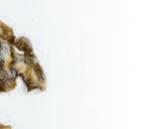
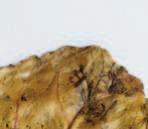
1 tspkoshersalt
1 tsp smokedSpanishpaprika
½ cupParmesan,freshlygrated

1 cupall-purposeflour
2 eggs,beaten
2 cupspankobreadcrumbs
1 cupneutraloilforstovetopshallowfrying koshersalt
/ croquettes preparation / Cut the green tops from the beets, wash and set aside for later use. Wash the beet well, cut the top off, peel the skin and set aside for later use. Dice the beets small and place in a pot, add enough water to barely cover them, and bring to a boil; reduce to a simmer and cook until tender, about 12 minutes. Drain the beets, reserving the beet-colored water for later use. Transfer beets to a food processor, and pulse until fully mashed; transfer to a bowl, and let cool completely. Add the walnuts to the food processor, and pulse until walnuts are finely ground but not a paste. Combine the walnuts with the beet mash, salt, smoked paprika and Parmesan, and mix until evenly combined. Use a small ice cream scoop to portion the mixture, form small balls and place them on a baking sheet lined with parchment paper. Freeze until solid.
Set up a standard breading procedure in three bowls: flour, beaten egg and breadcrumbs. Dip each ball in the flour, shaking off any excess – then dip into the egg mixture and then into the breadcrumbs – and set back on the baking sheet while finishing the other balls. Add oil to a deep cast iron pan, and heat over medium until shimmering hot (or 325˚F). Fry a few croque es at a time, turning o en until nicely brown on all sides. Transfer the croque es to a baking rack, and sprinkle with more salt. Serve immediately.







YIELDS | 1 TO 2 CUPS |

1 Tbspextra-virginoliveoil

1 tspMaldonsaltflakes greenbeettops
/ greens chips preparation / Preheat the oven to 375˚F. Spread the clean green beet tops evenly across a large, parchment paper-lined baking sheet. Drizzle with olive oil, and sprinkle with salt. Bake until brown and crispy, about 12 minutes.



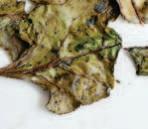

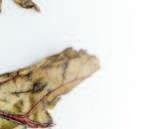


YIELDS | 1 QUART |
1 cupbeetskinsandtops,roughlychopped ½ cupgranulatedsugar



5 cloves,whole

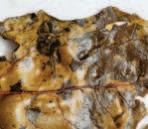

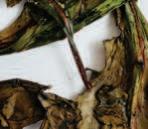


1 cupbalsamicvinegar


1 cupbeet-coloredwater sparklingwateror clubsoda(forserving)




/ shrub preparation / Place the beet peels in a quart-size glass jar. Add the sugar and the cloves. Use a muddler or wooden spoon to muddle the mixture together, working the sugar into the peels until the peels begin to sweat. Add the balsamic vinegar and the beet-colored water, and cover with a lid. Set aside at room temperature for five days. Strain through a mesh strainer, and store in the fridge for up to six months. To serve, add 2 ounces of the shrub to a tall glass filled with ice, and top with club soda or sparkling water. Stir with a large spoon, and enjoy it like a soda pop.

This booklet offers coupons for 20 different GDA-certified restaurants. The deals are valid for the rest of 2023, and the passport is available on GDA’s website.
 WRITTEN BY MARY ANDINO | PHOTOS BY SEAN LOCKE
WRITTEN BY MARY ANDINO | PHOTOS BY SEAN LOCKE
If you’re looking to make more eco-friendly choices when dining out, nonprofit earthday365's Green Dining Alliance program is here to help. According to program manager Ben Daugherty, GDA collaborates with local restaurants to lower their environmental impact through a rigorous inspection process. By eating at a GDA-certified restaurant, you can rest assured that you’re doing your part to help the environment.
How does GDA work with local restaurants?


We’re a resource for businesses in the food and beverage industry to be more sustainable. We do that through an on-site audit and walk-through where we sit down with the owners, managers. We look for ways to help them improve their environmental footprint. We try to be there as a support, as a resource to help these businesses implement some different sustainable practices to be greener and more cost-effective.
What does the GDA certification process entail?
We have our core concepts that all GDA members have to abide by. They can’t use Styrofoam; they have to use something that’s recyclable or postconsumer or compostable. The other core concept is that they will be recycling. They also have to have some waste-reduction processes in place. In terms of the more in-depth audit process that
we do, we look at a series of different arenas – we look at packaging waste, we look at food waste. We also look at energy conservation and efficiency and water conservation and efficiency. Food sourcing and procurement is a major piece of the audit where we look at locality and certifications such as USDA organic, Certified Naturally Grown, hormone free, steroid free, pasture raised,sustainably harvested seafood and fair trade, to name a few.
How does GDA combat “greenwashing”? There are terms like “local, natural, fresh” that are thrown out there a lot. While local is great, it doesn’t always necessarily mean it’s a good product or a sustainable product. [Greenwashing] is definitely a challenge. As the Green Dining Alliance, we’re there as a resource to kind of do that work to vet out any kind of greenwashing with our GDA establishments.
What projects does GDA have in the works for 2023? We received some really good grant funding. One of those is for composting, so we’re able to support GDA members that are composting or looking to compost. One of the other grants that we received is for plastic waste reduction, a kind of litter and disposables reduction within food businesses. We’re going to be meeting with neighborhood representatives to get us in touch with the different businesses to help reduce litter in the streets [and] in the neighborhoods. The grant is going to provide funding to any businesses to replace Styrofoam with a material that’s less harmful to the environment.
Green Dining Alliance, 314-282-7533, greendiningalliance.org
In order to reduce packaging waste, people can download an app and go to select GDA restaurants to get a Kind Box – a reusable container for takeout orders.
Each year, GDA hosts Green Dining Week. Each day, a portion of sales from select GDA-certified restaurants will go to support the GDA.

THIS MONTH’S COCKTAIL CELEBRATES
BOTH ST. PATRICK'S DAY AND UTILIZES WHAT YOU ALREADY HAVE IN THE PANTRY. Not everyone has a fully stocked bar with spirits and liqueurs to choose from, and you might not want to run to the store to buy a bunch of bottles you potentially will not use again. But with a little ingenuity, you can almost always make a delicious cocktail with what you have on hand. Don’t have vanilla beans? Use an extract. Don’t want to buy Chareau? Muddle a few mint leaves into the syrup right before shaking.
This whiskey-forward cocktail is slightly herbaceous – with just the right amount of sweet-and-sour balance.
1 cup orange juice, freshly squeezed
1 cup granulated sugar
1 vanilla bean pod, split lengthwise, scraped and dropped into mixture
/ preparation / Bring juice and sugar to a boil in a medium saucepan, stirring occasionally to prevent any scorching. When sugar dissolves, add vanilla pod and simmer for a few minutes. Take off heat, and let syrup cool completely. Strain and store in refrigerator. Keeps for about one month.

YIELDS | 1 DRINK |
2 oz Bushmills IrishWhiskey
½ oz orange vanilla syrup
¼ oz lime juice
1 BarspoonChareauAloeLiqueur greenmaraschinocherries (for garnish)
/ preparation / Place maraschino cherry in the bottom of a coupe glass. Shake whiskey, syrup, lime and Chareau in a shaker tin with ice for 10 seconds. Double strain into coupe. Serve immediately.

shops of Shaw, SweetArt stands out. It is many things all at once: art studio, café, a Black- and family-owned bakeshop – it’s the kind of place from which creativity bubbles up and out into the community. And it’s the kind of place you’ll keep thinking about even after you leave –especially if you order a signature Big Momma cinnamon roll.
The menu – in all its vegan and vegetarian glory – boasts crowd faves like the Sweet Burger, made with lettuce, tomato, vegan “magic” spread





made using old-school techniques and sandwiches named after Black creatives like essayist and playwright Zora Neale Hurston and poet Nikki Giovanni. Beyond partnering with locals like Mississippi Mud Coffee and Confluence Kombucha, SweetArt uses recyclable to-go boxes, cupcake trays and compostable containers.
SweetArt, 2203 S. 39th St., Shaw, St. Louis, Missouri, 314-771-4278, sweetartstl.com






Wandering into Small Batch in Midtown is like stepping into a whiskey lover’s black-and-white daydream. The tiled floors and all-black wooden bar, tables and chairs create a stark contrast to the perfectly white counters and tabletops; the large, round, hanging lights harken back to times past.
But one detail feels quite contemporary, especially when paired with so much whiskey: The food menu at Small Batch is entirely vegetarian. “Simply by virtue of being a completely vegetarian restaurant at Small Batch, we reduce our carbon footprint, as meat production in general produces a lot of emissions,” co-owner Kara Bailey says. Bailey and her husband Dave run Baileys’ Restaurants, including St. Louis staples Rooster, Baileys’ Chocolate Bar and Baileys’ Range, among others.
“We take multiple steps, company-wide, to be more sustainable,” Bailey says. “We procure our food locally as much as possible – including mushrooms and other fruits and vegetables –along with making our own breads, sauces and seasoning mixes.” All of the Baileys’ eateries have received five-star ratings from the Green Dining Alliance.


Small Batch Whiskey & Fare, 3001 Locust St., Midtown, St. Louis, Missouri, 314-380-2040, smallbatchstl.com
Anybody who has lived in St. Louis knows that South Grand has a stretch of supreme restaurants and bars. Some of the city’s best spots are located here, including Pizza Head, the punk rock pizza parlor with a nose for sophisticated flavors. The pie palace is all vegetarian, with vegan options, and for good reason: “Plant-based meats – and plant-based cheeses – produce significantly less greenhouse gasses, consume much less water and require less land to create than their animal-based counterparts,” co-owner Dylan Dodson says.
Even better, Pizza Head strives to do good around town. The restaurant works with local foodshare organizations to coordinate pickups of leftover slices, salads and incorrect orders. And, if pies can’t be donated, they still go toward helping the planet. “We started working with a composting company to compost food that we can’t otherwise donate or use,” Dodson says. “They weigh our bins when they pick [them] up, and our total emissions saved from composting in 2022 was the equivalent of taking two cars off the road.”
Pizza Head, 3196 S. Grand Blvd., South Grand, St. Louis, Missouri, 314-266-5400, pizzahead.com
Must-TryDish become“TheLion’sManedishhas bothacustomerand“Itstafffavorite,”Baileysays. mushroom[consistsof]aLion’sMane cake,roasted vegetablesandpreserved lemonrelish.”
Must-TryDish Dream"Don’tmisstheVeganUtopian VeggiePie,"Dodsonsays. “Ourhousemadecashewcheeseis makesmixedwithtomatosauce,[which] mushrooms,upthecreamybase.Spinach, artichokes,blackolives,onions,greenpeppersand mincedgarlicarepiled highontop.”

St. Louis is a scrappy city, and perhaps some of that scrappiness crosses over to the food industry, where restaurants and their respective bars put emphasis on helping one another – and our diverse biome as a whole – by sharing kitchen scraps that would otherwise go to waste. From utilizing backyard gardens in the city to giving Granny Smith apples new lives in the form of kimchi, St. Louis is full of spots doing their due diligence when it comes to sustainability.

Take Root Hospitality – the restaurant team behind Vicia, Bistro La Floraison, Taqueria Morita and Winslow’s Table – makes local food a point of focus. “When we changed formats to offer the Farmer’s Feast, [a seasonal threecourse, chef-selected menu experience], it dramatically changed how we were able to not waste product,” Take Root Hospitality co-owner Tara Gallina says. “We also cross-utilize ingredients at the bar and across all our restaurants. If we get in a whole pig, we use prime cuts for our tasting menu, skin for chicharrones at Taqueria Morita, sausage for Bistro La Floraison and ham for sandwiches at Winslow’s Table.” Vicia bar manager Phil Ingram takes pear cores and transforms them into infused spirits for the bar, Gallina adds. In general, the drink menu is influenced by what’s growing in the restaurant’s garden, with Ingram finding clever ways to use plentiful ingredients, such as rhubarb and fennel.

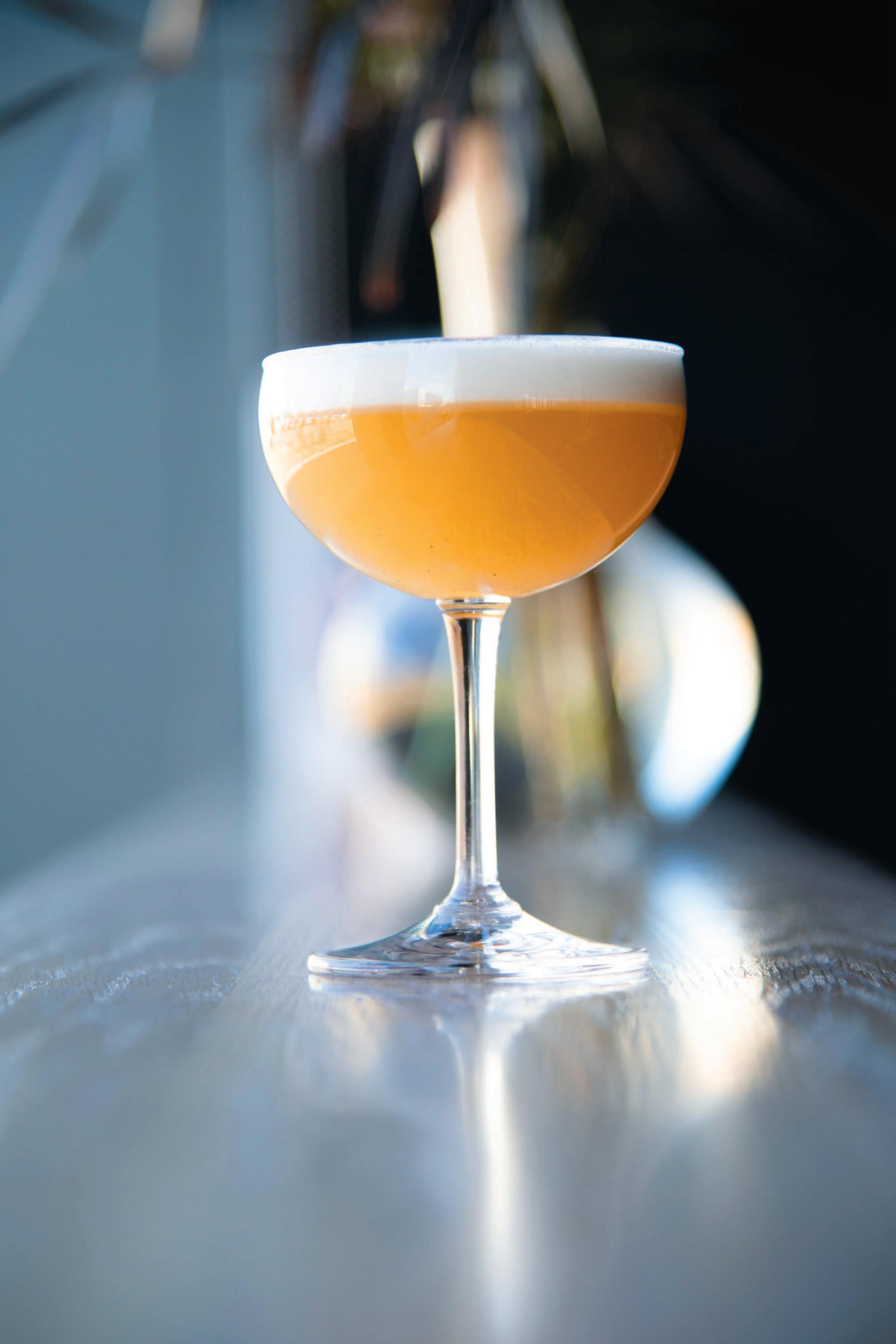
Vicia, 4260 Forest Park Ave., Central West End, St. Louis, Missouri, 314-553-9239, viciarestaurant.com



Although The Royale humbly touts itself as a “neighborhood public house,” it’s all that and more. When the warmer months allow, the brick building’s exterior boasts a lush courtyard with its own garden. Much of the garden’s produce ends up on plates in the kitchen and in drinks at the bar. “Our garden has been a boon to our menu,” owner Steven Fitzpatrick Smith says. “We’ve harvested Cucuzza squash, service berries and jujubes, which we’ve incorporated into the menu. We use peppers, lavender, herbs, grapes and more in our drinks.” Smith points to one drink in particular, the Queen of the Vines cocktail. It’s made with The Royale’s from-scratch grape juice shrub, Pisco brandy, egg whites – or a foamed, vegan substitute – angostura bitters and nutmeg.


The bar-and-kitchen combo at paradise-themed restaurant Yellowbelly is a masterclass in low-waste mixology and cooking. “Outside of careful ordering and inventory, the biggest way to reduce food waste is fermentation,” co-owner Tim Wiggins says. The restaurant uses Granny Smith apples and leftover cabbage, cauliflower and cucumber for kimchi; it brews Tepache – a fermented Mexican beverage prepared with piloncillo, a type of brown sugar – by saving the skins and cores of pineapples. “We use the Tepache for garnishing oysters and in mimosas at brunch,” Wiggins says. “We also do this process with watermelon in the summer.” Other items make their way into many quintessential Yellowbelly drinks: “Our housemade ‘curry pack’ with fresh galangal, curry leaves and lemongrass gets made into a clarified cordial for our Instant Gimlet cocktail,” Wiggins says.



Yellowbelly, 4659 Lindell Blvd., Central West End, St. Louis, Missouri, 314-499-1509, yellowbellystl.com

YELLOWBELLY USES TEPACHE TO GARNISH ITS OYSTERS
What different educational opportunities does EarthDance offer?
We offer two different programs: One is more tailored toward gardeners and is five weeks long in the spring, and then one is because we knew that people wanted an immersive thing. … It’s 40 hours a week for 10 weeks of the summer. We call it the summer apprenticeship now. It’s really geared toward a lot of college students or recent grads who are looking to get into farming. We also have an agri-culinary internship program in partnership with Innovation High School, which is part of the Ferguson-Florissant School District. … It’s a really out-of-the-box learning model. … It’s all very project-based and very “real world” experience-based. Students at Innovation can choose to come to the farm a few days a week. … What they’re focused on is learning how to use really fresh ingredients.
What sustainable growing practices does EarthDance implement?
We do almost no-till farming – so farming in permanent beds, rather than tilling the soil after each crop comes out. What that does is really build up the health of the soil. There’s the term food forest: Basically, our orchard is meant for it. It is creating a multi-story, multi-layer [system of plants] from the fruit trees down to the ground cover – like having strawberries as the ground cover and other herbs at a lower growing level than the trees. … It’s ultimately maximizing the yield in the footprint we have.
How does EarthDance view and prioritize food justice?
In the 15 years it’s been in operation, EarthDance Organic Farm School has continually brought sustainably grown produce and educational apprentice programs to Ferguson, Missouri. For CEO and founder Molly Rockamann, agriculture represents the nexus of her passions; she sees it as a multicultural intersection of social justice, ecology, international development and human health.
In the pursuit of equity and food justice, EarthDance offers a paywhat-you-can farm stand, an online course for beginning gardeners and a full-time, paid apprenticeship program to help develop the next generation of farmers.

At EarthDance, we’re extremely committed to the health of the soil, and it goes so hand-in-hand with the health of the community. I think there’s a myth that some people still hold, which is that people without a lot of money don’t care about eating healthy, and that’s not true at all. It’s just that it’s often out of reach. We’re very dedicated to increasing healthy food access at EarthDance, and having the pay-what-you-can distribution model speaks to that.
EarthDance Organic Farm School, 233 S. Dade Ave., Ferguson, Missouri, 314-521-1006, earthdancefarms.org






Growing your own food is a great way to embrace sustainability, but on the surface, it can seem difficult to do in a city like St. Louis. There are more than 250 solutions, however, in the form of community gardens sca ered throughout the metro area, giving you a space to grow both produce and your relationship to your neighborhood.
“It’s people coming together in a community approach to actually grow food together,” Seed St. Louis CEO Ma Schindler says. Seed St. Louis is a longstanding local nonprofit dedicated to helping communities and people grow their own food. “The goals for the garden can be different,” Schindler continues. “They can be growing for individual families or themselves; they can be growing for the community around them; they can grow for a food pantry.”
Belleville Heart Garden and Community Orchard and the Soulard Garden Co-op are two such gardens, though each plays a distinctly different role in their communities.
Belleville Heart Garden is a demonstration space. The crops grown are free for all to harvest, and visitors are welcome from dusk to dawn throughout the week. The garden also offers education on sustainable growing. “We very much value learning over knowing,” garden steward Lori Powell says. She maintains the garden with help from Alan Elfrink and Jennifer Reiman. “We are there to collaborate, share resources and information and grow community … If you are looking to reconnect with
your sense of delight, curiosity and discovery through gardening, we are your people.”

The Soulard Garden Co-op functions as a more traditional community garden. For just $30 per year, you secure a garden bed in the community space to grow any crops you wish. Members also share in the upkeep and harvest in the communal areas, which house vegetables, berry bushes and fruit trees. “The garden adopted a vacant, weed-covered lot and turned it into a beautiful space that produces food for approximately 30 neighborhood families who share the work and then the food,” garden founding member Phyllis Young says. Any excess produce is donated to local nonprofit Food Outreach.
In addition to providing an affordable, sustainable way to source your food, community gardens give residents a way to connect with each other and improve their health, according to Schindler. During the pandemic, Schindler says Seed St. Louis saw its highest demand yet for new community gardens – and that number keeps climbing. “I think people realized the value of nature, growing their own food and eating healthier over these past two years,” he says.
Community gardens are also somewhat of an untapped resource for restaurants to source more ingredients locally. One of Schindler’s goals for Seed St. Louis is to encourage the local food and drink industry to embrace these gardens. “I think it’s part of the challenge, too, for restaurants to find local access to good quality produce,” Schindler says. “So we are really interested in having that discussion going further and be er connecting restaurateurs and foodies to our local produce.”
To find the community gardens closest to you, visit seedstl.org.
SOULARD GARDEN CO-OP
Cost: $30/year per garden bed
Location: 2331 S. 9th St., Soulard, St. Louis, Missouri
How to get involved: Reach out to soulardgardencoop@gmail.com or visit soulardgardencoop.com to sign up for the wait list.
Cost: Free
Location: 806 and 720 S. High St., Belleville, Illinois
How to get involved: Volunteer hours are Wednesdays from 4:30 to 6 p.m. and Saturdays from 9 to 11 a.m. from March 18 to Nov. 4.
Cost: Free
Location: 5501 Delmar Blvd., Suite B270, St. Louis, Missouri
How to get involved: Volunteer with Seed St. Louis by building, planting and learning at its demonstration garden. Visit seedstl.org to learn more.







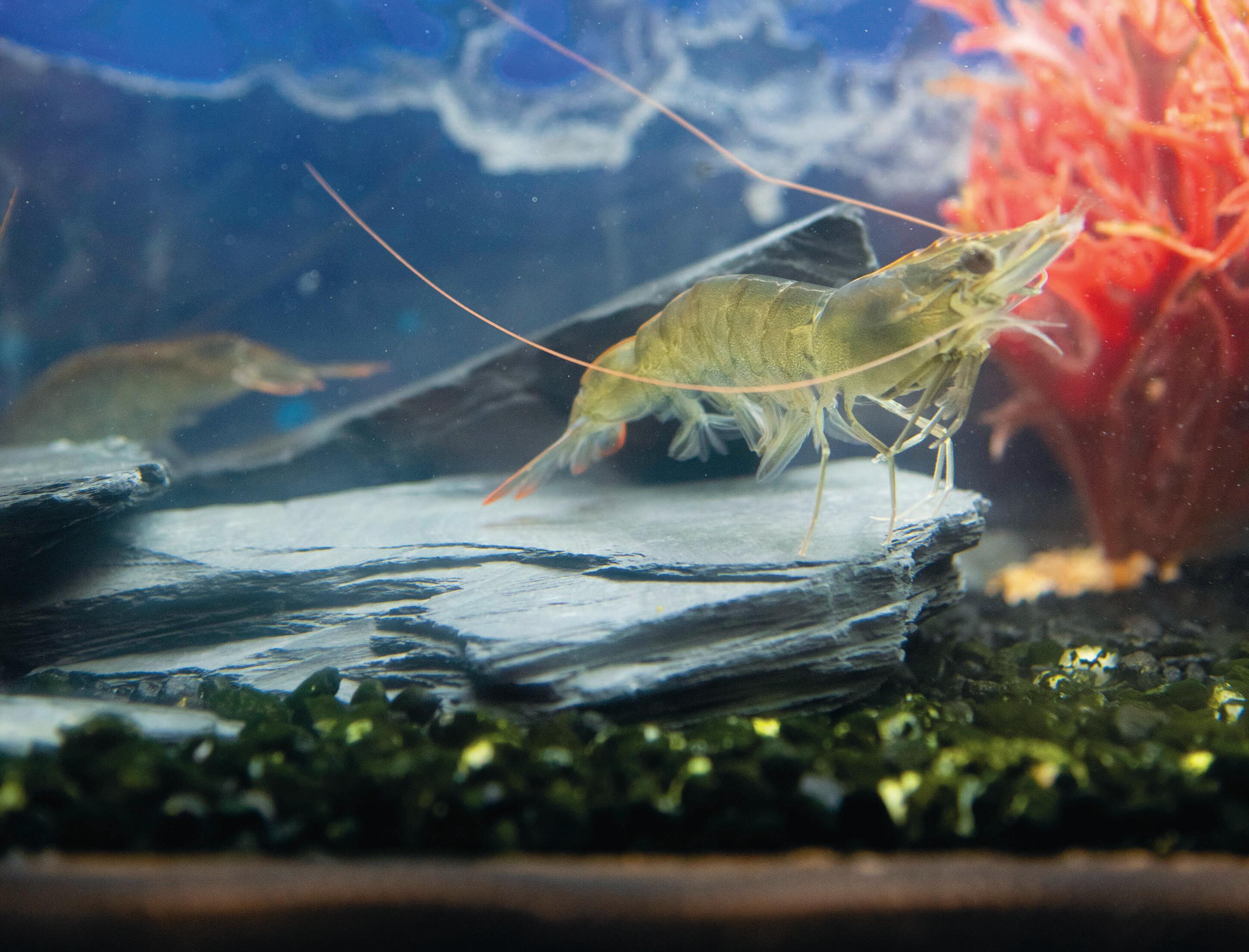 PHOTO BY CHRISTINA KLING-GARRETT
PHOTO BY CHRISTINA KLING-GARRETT
bout an hour west of St. Louis in Foristell, Missouri, is Triple J Farms – a well-kept cluster of buildings situated in the middle of picturesque Midwestern farmland. This isn’t your typical Missouri farm, however. Instead of cattle or corn, at Triple J, the Howell family is growing sustainable Pacific white shrimp.
Jeff Howell, who coowns Triple J with his brother James and their parents Dave and Sandi Howell, comes from a long line of farmers. Thanks to the generations before them, he and his brothers have been around agriculture all their lives. “One day, my dad was reading an article in ‘The Soybean Digest,’ of all places, about how you could make shrimp feed out of soybeans,” Howell says. “We were soybean farmers, so that got him interested in aquaculture.”
After much discussion and research, Howell began developing business partnerships with Florida hatcheries, where the shrimp spawn in a controlled environment. From a building with a dirt floor, the family built out the current facility in Foristell, complete with 14 saltwater tanks and two nursery tanks. Now, the baby shrimp arrive at Triple J via overnight UPS in groups of 30,000 – each one the size of an eyelash.
Triple J uses heterotrophic bacteria – groups of microorganisms that eat shrimp waste and clean the tank water in the process. This symbiotic relationship is intensely monitored by Howell, who conducts 11 tests on the water daily. “We don’t use any filters or electricity in the waste-removal process,” he says. The large tanks produce 110 pounds of shrimp each.
Pacific white shrimp are among the most widely cultivated shrimp in the world and can be easily grown in pools. According to the Monterey Bay Aquarium Seafood Watch
program, 90 percent of shrimp sold on the U.S. market is imported. By producing shrimp domestically, farmers like the Howells reduce reliance on international shipping, carbon emissions and air pollution. Today, Triple J supplies local restaurants, such as Clayton’s Bar Moro, with shrimp for their menus.
Pacific white shrimp farmed in U.S. ponds have a green, “best choice” rating on the Seafood Watch list. These shrimp are more eco-friendly than those farmed worldwide in indoor recirculating tanks; one reason for this is a lack of chemicals in ponds.
Sustainability efforts often start at the grassroots level, and one St. Louis chef who takes environmental health to heart is John Messbarger III, chef de cuisine at Peacemaker Lobster & Crab. Located in St. Louis’ historic Benton Park neighborhood, Peacemaker is known for its lobster boils, steamed clams and dazzling raw bar.
“I’m pretty aggressive environmentally with everything I do,” Messbarger says, explaining that he keeps additional energy usage down by shipping on daily flights already bound for the Midwest. “Planes are already traveling from Boston to St. Louis – or somewhere along that route – so we get [our seafood] thrown on with commercial flights,” he says.
Along with shrimp, a rotating selection of oysters also appear on the Peacemaker menu. “Oysters are a major help in ocean sustainability because they filter the water and help everybody in the process,” Messbarger says. From Kumamoto oysters in Washington to Eastern oysters in Massachusetts, these bivalves clean the habitats of other sea creatures – a significant help to threatened fish species like Atlantic halibut and Beluga sturgeon.
Dominic Weiss – owner and executive chef at Big Sky Café in Webster Groves – has been composting much of the restaurant’s food waste, including its seafood, for more than two decades now.
To source its seafood, Big Sky uses Illinois-based Fortune Fish & Gourmet. Like Big Sky, Fortune Fish recycles and composts in its offices, as well as repurposes all its seafood trim, bones and heads.
All along the supply chain, Weiss points out, leaders in each industry can do their part. “For a while, wildcaught was the way to go,” Weiss says.
“And that’s what you’d hear the most: ‘Wild-caught is lowestimpact; wild-caught is better regulated.’ But
that’s not necessarily the case anymore. There’s a lot of agriculture out there that’s hyper-focused on being environmentally sustainable.”
Big Sky also works with Riverence, a steelhead trout farm near the Snake River in Idaho. Rated as a green, “best choice” Seafood Watch option, the trout are raised with minimal impact to the environment – meaning without growth hormones, preventative antibiotics or genetic engineering.
Trout is a well-known eco-friendly fish worth ordering at dinner, Weiss explains. However, he also notes that cooking with less familiar fish is another way to bring sustainability into your kitchen, especially when popular varieties – like Bluefin tuna – are heavily overfished. “Arctic char is one of the most sustainable fish out there – and maybe one that not everyone is familiar with – but I tell people it’s a cross between trout and salmon, so it’s a very approachable fish,” Weiss says.
Both Big Sky and Peacemaker use leftover bits of fish and crustaceans for seafood stock, and the Howells suggest using shrimp heads to make stock at home. At Triple J, the shrimp molt in their tanks and the leftover shells are used in the garden. The shrimp that don’t make it are used as fish bait.
Interested in getting involved in eco-activism on the local level?
Try the Great Mississippi River Cleanup, which has removed more than 610,000 pounds of debris from the river. In 2017, two separate groups of scientists determined rivers to be the main source of plastic pollution in the ocean.
Check out St. Louis’ Green Dining Alliance website at greendiningalliance.org and the Seafood Watch list at seafoodwatch.org for more information on sustainable seafood efforts.
Big Sky Café, 47 S. Old Orchard Ave., Webster Groves, Missouri, 314-962-5757, bigskycafe.net
Peacemaker Lobster & Crab, 1831 Sidney St., Benton Park, St. Louis, Missouri, 314-772-8858, peacemakerlobstercrab.com
Triple J Farms, 3103 Hwy. T, Foristell, Missouri, 636-828-4144, triplejfarmsstl.com






















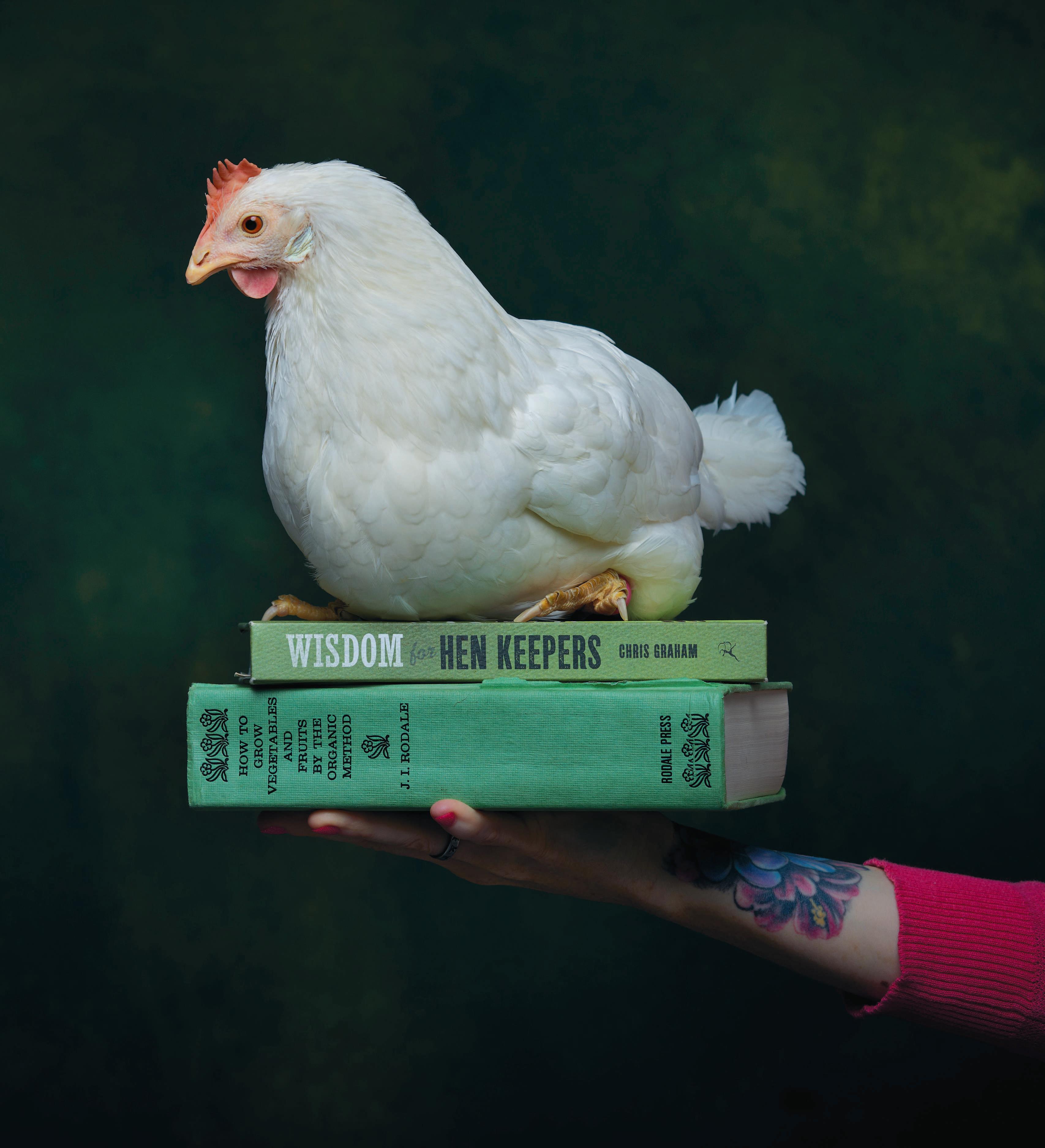


“I grew up on a farm and was that little kid who always bonded with the animals not meant to be pets. … That repeated experience [of life and death] was traumatic for me,” she says. “Things can go one of two ways: You either become desensitized to the way things are and just carry on what was done before, or it has a dramatic effect on you and you want to do the opposite. The second way is what it was for me.”
Each year in the U.S. alone, egg producers dispose of about 300 million “spent hens.” These chickens, after being deemed unproductive for egg laying, are eliminated and go to waste. Camp, who is now the founder and president of St. Louis-based nonprofit Second-Hen’d, is on a mission to change this – one chicken at a time.
Camp, an army veteran, settled in St. Louis in 2010 and began looking into raising chickens of her own. She found there were well-established groups and nonprofits in the U.K. that re-home “spent” hens, but a program like that didn’t exist in the U.S.
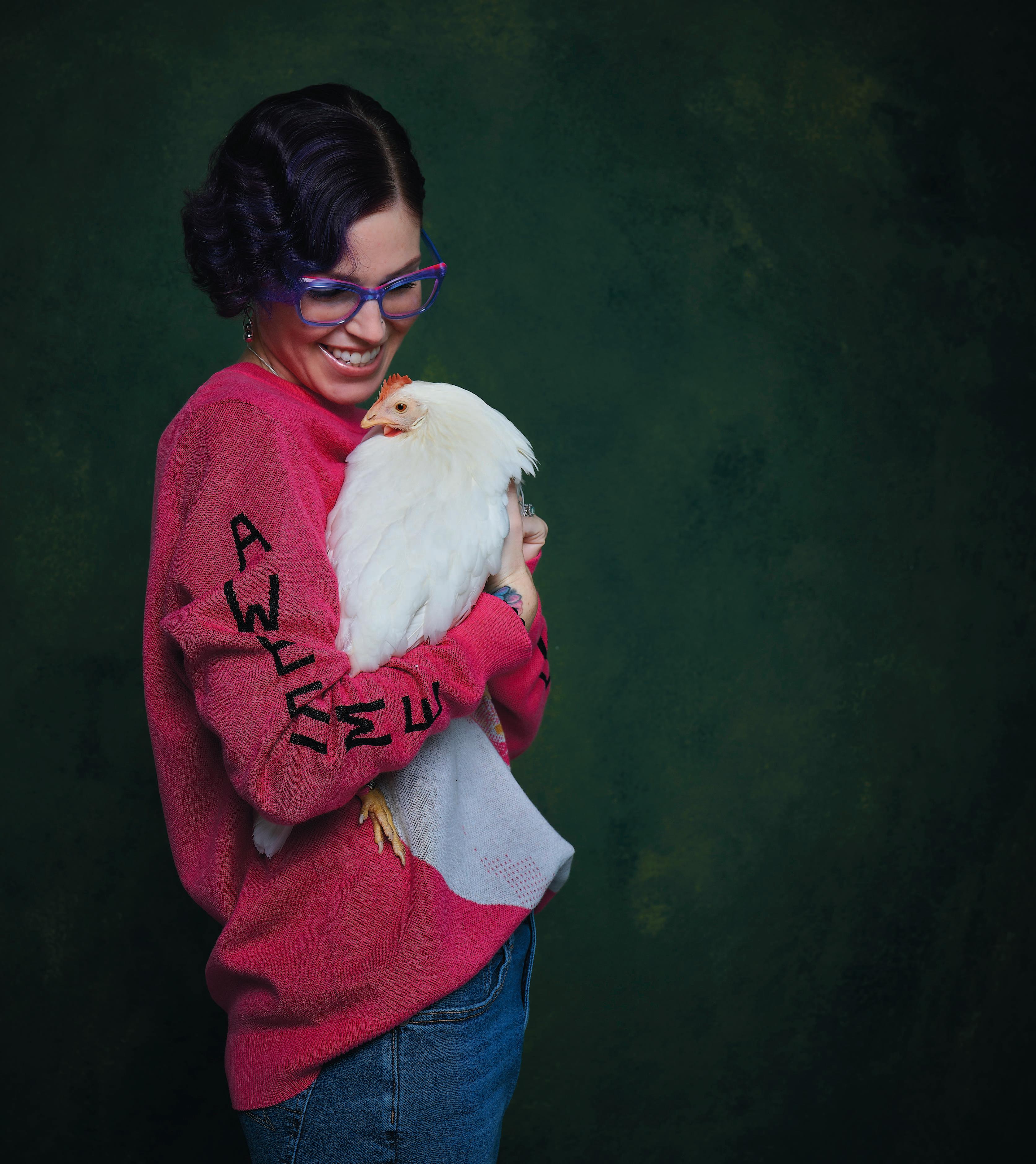
“I wanted to save them from a situation where the other alternative was certain death,” Camp says.
She began contacting egg producers in 2015 to set up relationships, but she says it was tough at first. Farmers thought she might be trying to do undercover exposés on their practices. Two years later, she finally found an egg producer willing to collaborate, and they developed a productive partnership.
Although egg producers call them “spent hens,” these birds are anything but, Camp says. “They usually get rid of them around a year to two years old,” Camp says. “They hit their first molt, and so they lose all of their feathers and grow new ones back.”
The chickens’ bodies then need to focus all energy on regrowing feathers, so egg production stops; this process can take two to three months. “It’s not cost effective for [the egg producers] to pay for their care while they’re not producing eggs, so it’s cheaper to just
WHEN YOU SPEAK TO ERICA CAMP, THE FIRST THING THAT BECOMES CLEAR IS HER DEEP LOVE AND ATTACHMENT TO CHICKENS.>>> Pictured left, Erica Camp and Blossom Poulet. Pictured right, Rebecca Clark and Ducky
get rid of them,” Camp explains. However, she adds, once the hens complete their molt, they will continue laying eggs and can live up to 10-plus years.
Camp’s organization Second-Hen’d prides itself on the many ways its operations promote sustainability. Not only is the nonprofit saving these birds from what would be certain death, but also, if the birds lay eggs during their quarantine, Second-Hen’d donates them to local food banks. The chickens can even make a difference when it comes to the adopter who is looking to lower their environmental impact. “Chickens are great for composting: They’re natural tillers that will diligently work a compost pile. High in nitrogen, phosphorous and potassium, their poop is fantastic fertilizer,” Camp says. “Their eggshells can also be added to garden soil for a boost in calcium.”
Once it receives the birds from egg producers, SecondHen’d focuses on getting them healthy and adoptable. “We get these chickens in rough shape,” Camp explains. “The only human interaction that they’ve had was limited. So we have to earn their trust and show them that we’re not a threat.”
When searching for residents who are qualified and ready to adopt the birds, Camp isn’t looking for people who just want a cheap source of eggs. Her ideal adopters are people who treat these chickens as someone would treat their dog or cat – as part of the family.

Jenny Connelly-Bowen and Adam Bowen are one such pair; they began adopting chickens from SecondHen’d three years ago, and their birds have become indispensable to their daily lives.
“They were in rough shape when we first got them … and it was just really fun watching them recover and learn to be chickens,” Connelly-Bowen says.
“They’ve never had the opportunity to get up and move around on their own, so it feels really meaningful to be able to provide that for them,” Bowen adds.
Although the duo says there was a learning curve when it came to daily care, the biggest lesson came from
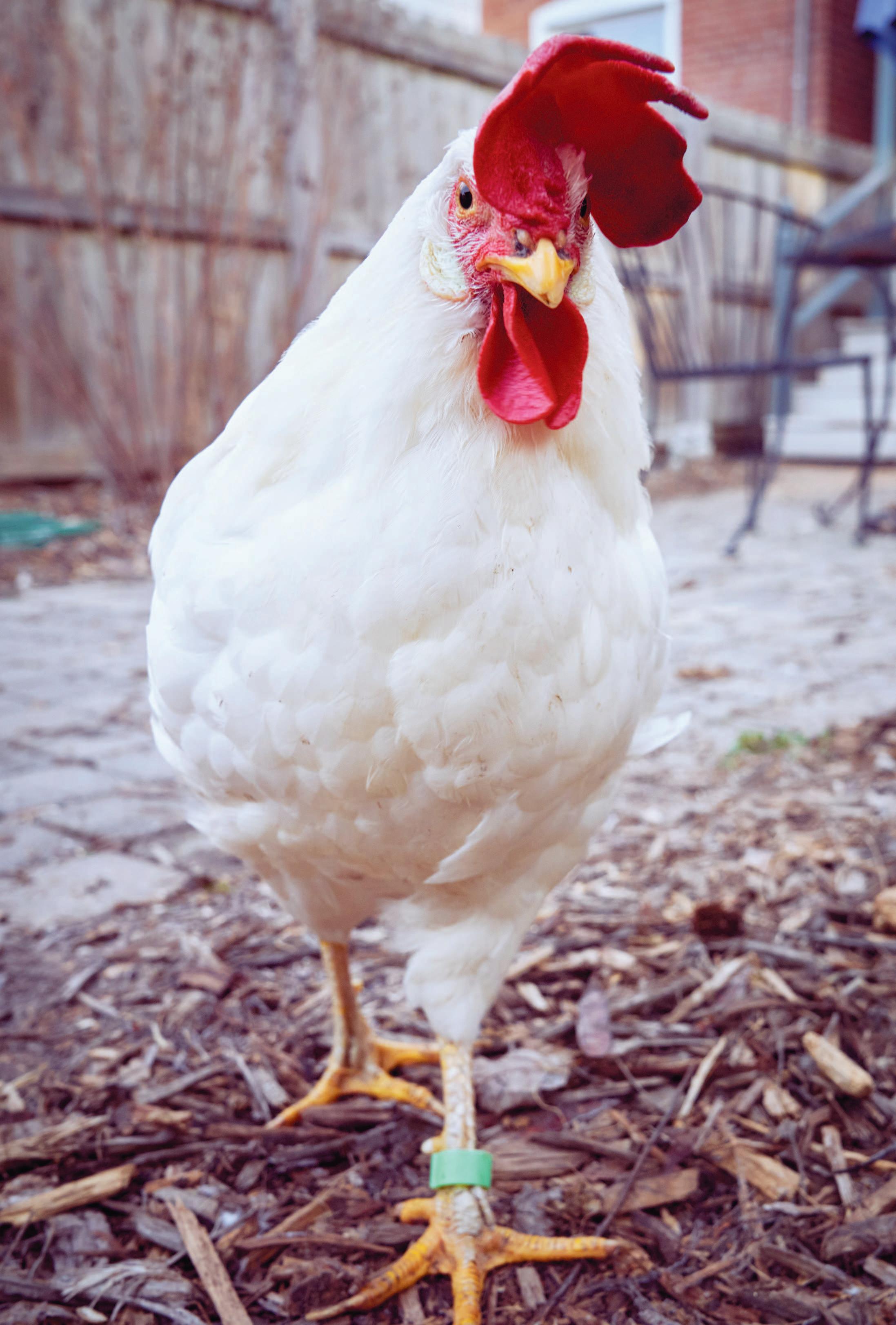
I have this girl right now, Ducky, and she’s very intuitive. I have severe depression, and when I’m having a bad meltdown, she knows and will actually follow me around and make sure that I’m ok.
– REBECCA CLARKOne of Jenny Connelly-Bowen and Adam Bowen's hens
trying to form bonds with the chickens. “How do you deal with an animal that hasn’t been able to form those kinds of relationships before?” Bowen asks. “Part of that is also learning what chicken affection looks like.” Over time, the couple says, the birds came out of their shells and embraced them as protectors.
The two have one main takeaway from their experience: Chickens have character and are worth cherishing. “Chickens have personalities, just like any other animals that you might meet,” Connelly-Bowen says. “They definitely have unique emotions and minds.”

Chickens share another quality with dogs and cats: their potential to be therapeutic. “As a disabled vet, the main things I struggle with are depression, anxiety and PTSD,” Camp explains. “Chickens are perfect [for] therapy because now I have a reason to get out of bed in the morning. Their survival and ability to thrive require my utmost attention.”
Second-Hen’d Vice President Rebecca Clark has also found comfort and solace in her chickens: “I have this girl right now, Ducky, and she’s very intuitive. I have severe depression, and when I’m having a bad meltdown, she knows and will actually follow me around and make sure that I’m OK.”
Clark says that the nonprofit is working to find ways to extend the therapeutic benefit of chickens to the community at large: “Before COVID, we worked with a school for kids with autism; we’d take our chickens and some chicken-themed books and go read to the kids. Afterwards we’d have sensory time. There’s just something about these chickens that the kids really love.”
“We sometimes hear from staff that, ‘Oh my gosh, we’ve never seen this child smile like this before,’” Clark adds. Second-Hen’d is hoping to expand the program and offer it in more schools and potentially nursing homes in the future.
Given its grassroots nature, incredibly small team and limited resources, Second-Hen’d can only rehome two to three hundred birds per year. In the future, Camp would love to see the program become as robust as its counterparts in the U.K., but in order to do so, SecondHen’d needs to secure more funding, volunteers and a permanent plot of land in the city. No matter what though, Camp, Clark and Second-Hen’d adopters won’t give up on providing these birds a beautiful, safe home for the rest of their natural lives.
Camp says she strongly identifies with these chickens that have so much potential – but that are still seen as expendable. “In the military, when you’re so broken and so done, they no longer have any use for you,” she says. “We’re just trying to show that these birds still have a purpose and so much left to give.”
Second-Hen’d, St. Louis, Missouri, instagram.com/2nd.hend/
 WRITTEN BY CHARLOTTE RENNER / PHOTOS COURTESY OF GROWACTIVE SOLUTIONS
WRITTEN BY CHARLOTTE RENNER / PHOTOS COURTESY OF GROWACTIVE SOLUTIONS
When you decide to start gardening, the most important thing to bring with you to the garden shop is a plan, according to GrowActive Solutions managing partner Beau Bradley. Get to know your space and how much time you can devote to it, decide what crops you want to grow and make a trip to GrowActive Solutions in Tower Grove South – they’ll help you handle the rest. “We don’t care what you grow or how you grow it, as long as you’re growing,” Bradley says. “So with every single customer, we take as much time as we need to in order to set our clients up for success, whether that’s 15 minutes or three hours, doesn’t matter.” Here, Bradley recommends three must-have products that can be found at GrowActive Solutions to set your garden up for success.

GrowActive Solutions, 3612 Hartford St., Tower Grove South, St. Louis, Missouri, 314-899-0179, growactivesolutions.com
COMPOST: “Compost is always the best thing when you’re starting a garden. Getting more organic matter back into the earth is always great. We have pre-made compost, bagged and ready to go. It just helps get the microbiology – the fungus and the bacteria – really thriving again. It also helps increase the rate of decomposition, so that way, more nutrients become available to the plants.”
WORM CASTINGS: “It’s another form of compost that has a different microbiology, and the nutrients that are available depends on what those worms were fed. But the biggest bonus to earthworm castings is that they help bring earthworms back, so they help attract beneficial insects. They’re going to help aerate your soil so that it’s not so compact [and] allow your roots to breathe better. They’re going to start to eat some of that waste and to re-fertilize the garden. This is part of the soil food web.”
AZOMITE: “It’s like a volcanic rock. It has all the trace minerals that a plant needs. Trace minerals are the little building blocks of life that really help a plant thrive. Azomite will also help create more nutritious food for you because you’re enriching the soil with things that generally aren’t there – or that other fertilizer [producers] are not putting into their fertilizer. A lot of our fruit and vegetables are not as nutritionally dense today as they were generations previously due to modern agriculture practices, so adding trace minerals helps produce nutrient-dense food.”
Small steps toward sustainable living can make a big difference in your community. Although it does require intentional effort, developing responsible routines makes this transition easier to maintain. Here, Feast digital editor Shannon Weber shares her advice for low-waste living.

The St. Louis metro area is abundant with farmers and makers. Whether you shop one of our many local farmers markets or sign up for a Community Supported Agriculture membership, you’re supporting the local economy while simultaneously helping the environment by cu ing down on shipping and packaging. Beyond produce, peruse essentials like fresh and cured meats, cheeses, jams, sauces, honey, fresh bread, dog treats and more at local markets. Make a list, bring a tote and don’t be afraid to try something new.



When building or updating your kitchen, always try to opt for energy-efficient products, which will also lower utility costs in the long run.
Quality is always more important than quantity when it comes to cookware. Some of the most prolific home cooks only use a few pots, pans and utensils to create their dishes. Invest in high-quality items as much as you can, and hand-wash them to extend their lives.

Consider purchasing tableware from a local ceramicist, such as Molly Svoboda of Boda Clay (bodaclaystl.com), who offers several glazes and designs, including serving bowls, mugs and vases. It’s practical art made sustainably that is designed to last much longer than cheap dishware.

Instead of demolishing old cabinetry, donate it to one of Habitat for Humanity’s ReStore locations or sell it on a resale site.
ESSENTIALS
Seek out shops such as Dharma + Dwell in Webster Groves (dharmaanddwell.com) which stocks a wide variety of kitchen essentials, including food storage, cleaning tools and plant-based alternatives to common kitchen plastics like trash bags.
HERBS
Find spots on your shelves to grow herbs indoors. You’ll benefit all year long, and it’ll add a li le natural freshness to your kitchen.
Make your own simple cleaner solution at home using vinegar and baking soda, which is naturally be er for the environment and safe for surfaces. Don’t want to DIY? Dharma + Dwell has all-purpose cleaning powders and dish soap, along with a line of refillable glass and aluminum containers.





Furnish your kitchen (or any space) with sustainable, natural materials: Think recycled woods, leather and metals. Head to vintage or secondhand stores before buying new to find unique, ecofriendly furnishings.

Gardens – even small ones – are a great way to add a layer of sustainability to your kitchen with ready-to-eat produce steps from your door. Use discards like eggshells and coffee grounds as natural fertilizer for plants and herbs, and keep a compost bin going nearby.


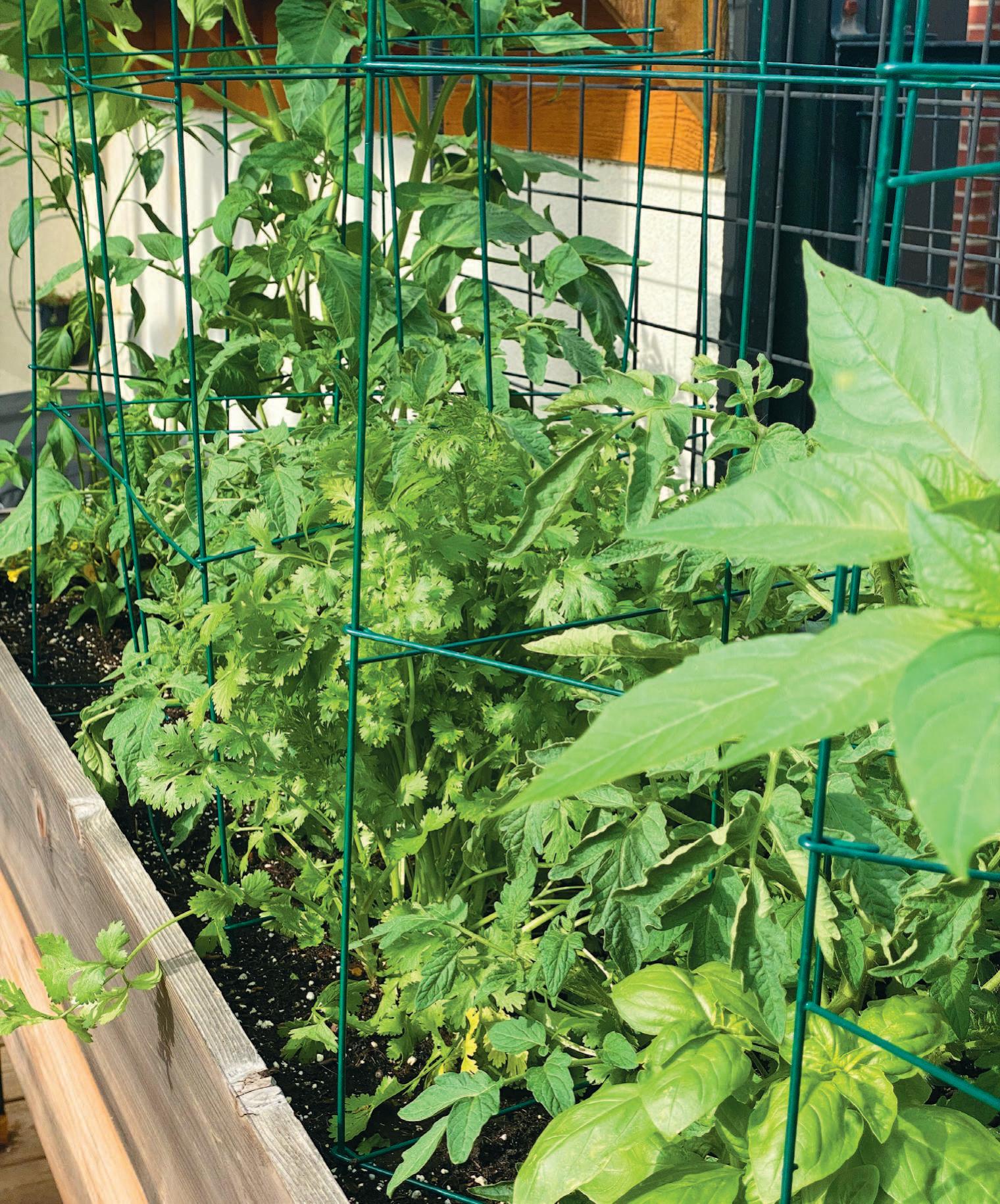

If you’re interested in composting but don’t know where to begin, you’re not alone. Thankfully, living in St. Louis means you have a variety of options for composting available at home.





PERENNIAL CITY | Perennial City composting serves St. Louis city and parts of the county by offering subscription services for weekly or biweekly home compost pickup. Your scraps become someone else’s treasure: Perennial City delivers them to Helt Bros. Farm in Illinois to feed heritage breed hens and nourish the soil. A full list of pricing and areas served is available at compost.perennial.city.
NEW EARTH FARM’S COMPOST STL | New Earth Farm in Old North St. Louis offers weekly and biweekly compost pickup for customers who subscribe to its Compost STL program, and it returns a bucket of compost to your door twice a year for you to use as fertilizer for your own garden soil. In addition to residential pickup, Compost STL offers compost drop-off and services for events or commercial customers. Learn more at compoststl.com.
DIY COMPOSTING | Consider DIY composting, which will provide you with an alternative to trashing your scraps and give you fresh nutrients to feed your soil. Resources abound for se ing up your composting bin outdoors, provided you have a li le space on your property to dedicate to it. If you’re low on outdoor space (or have none at all) consider alternatives like bokashi composting, which uses fermentation, or vermicomposting, which uses worms to transform your scraps into something your garden will love.


10.125”WIDEX11.25”TALL YELLOWBOXISTRIMSIZE:



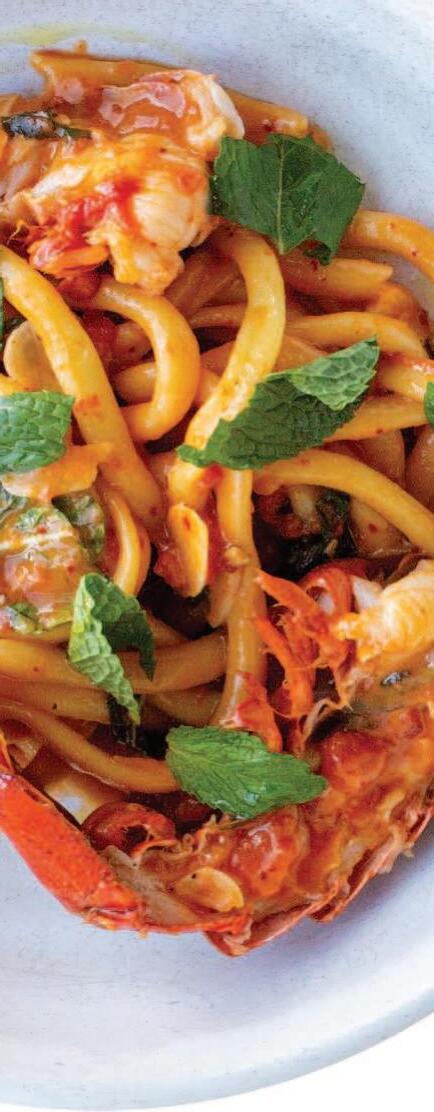
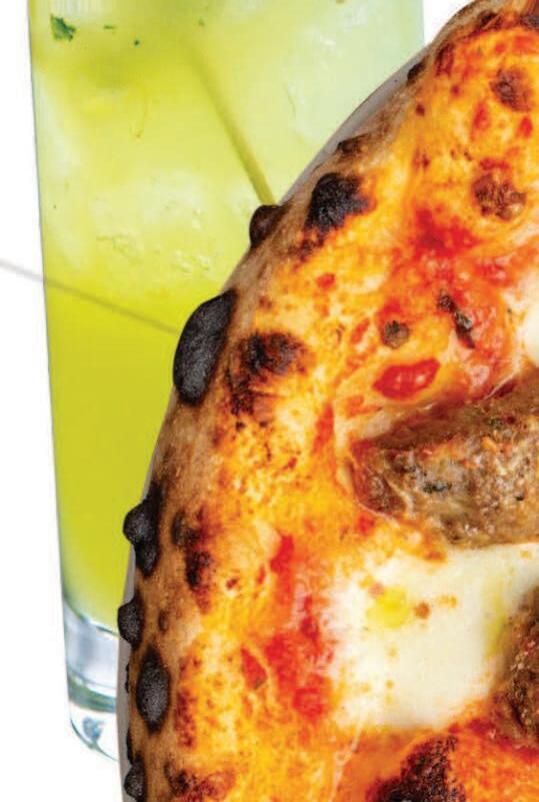







10.875”WIDEX12”TALL

